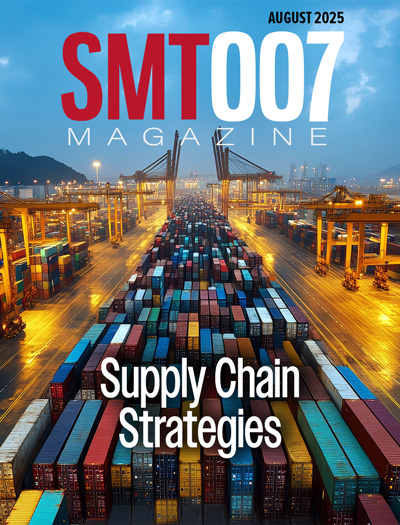-

- News
- Books
Featured Books
- smt007 Magazine
Latest Issues
Current Issue
Spotlight on India
We invite you on a virtual tour of India’s thriving ecosystem, guided by the Global Electronics Association’s India office staff, who share their insights into the region’s growth and opportunities.

Supply Chain Strategies
A successful brand is built on strong customer relationships—anchored by a well-orchestrated supply chain at its core. This month, we look at how managing your supply chain directly influences customer perception.

What's Your Sweet Spot?
Are you in a niche that’s growing or shrinking? Is it time to reassess and refocus? We spotlight companies thriving by redefining or reinforcing their niche. What are their insights?
- Articles
- Columns
- Links
- Media kit
||| MENU - smt007 Magazine
The Authors of the Printed Circuits Handbook 'Speak'
August 30, 2016 | I-Connect007Estimated reading time: 2 minutes
Editor’s Note: The seventh edition of the Printed Circuits Handbook was published this spring, which was also the 50th anniversary of the first edition. For this issue—“Voices”—we asked the many authors of the handbook for their thoughts—their voices. We asked a few questions to get them started; though not everyone spoke strictly about the handbook, we found their comments interesting and thought-provoking, and we hope you do as well. We begin with a wonderful history of the Handbook by the main man himself, Clyde Coombs.
Clyde Coombs Editor-in-Chief (Chapter 1)
The Printed Circuits Handbook is now in its seventh edition, and we are observing the 50th anniversary of the publication of the first edition. This long-term level of importance in an industry is remarkable, but the need for this book seems obvious today. This is to put the concept of the book into the context of the industry when the first edition was published, and try to explain why there was a book in the first place, and what led to this long string of successful subsequent editions.
Touring a modern, technology- and capital-intensive, highly-automated printed circuit factory of today, supported by a staff of trained specialists, many with advanced degrees in science, engineering and systems, would be a totally different experience than touring a printed circuit shop of 1959. For the most part, those shops were the creation of entrepreneur artisan platers or silk screeners, and the facilities were called “bucket shops” for good reasons. With the exception of IBM, Collins Radio, RCA, and a few others, along with the founding members of IPC, the estimated several thousand shops in the United States (numbers at the time ranged from 4,000 to 7,000) were operated by rules of thumb, years of experience in related trades, and generally considered an art, not a technology.
Shops were divided into two categories: captives, which made boards as a part of a vertically integrated OEM, and independents, which made and sold boards to OEMs that did not make their own. Both categories of shops could be justified since it was generally accepted that it did not take significant technical skill, or a large capital expenditure to start a shop. However, in 1959, the printed circuit world was on the brink of a major revolution that few shops were prepared to cope with, and most shop managers did not understand. The spark for this was the sudden introduction, and swift adoption, of the transistor into electronic devices. As vacuum tubes disappeared, and more functionality was designed onto much smaller boards, there was a sudden need to be able to connect circuits on both sides of a board reliably.
Editor's Note: This article originally appeared in the August 2016 issue of SMT Magazine.
Testimonial
"The I-Connect007 team is outstanding—kind, responsive, and a true marketing partner. Their design team created fresh, eye-catching ads, and their editorial support polished our content to let our brand shine. Thank you all! "
Sweeney Ng - CEE PCBSuggested Items
Building Electronics Excellence in India
09/08/2025 | Nolan Johnson, SMT007 MagazineFor over two decades, Dave Bergman has helped steer the Global Electronics Association’s work in India, from a single training course to a thriving regional operation with deep government and industry ties. In this interview, Dave explains how the group went from partnering with IPCA to opening its own office in 2010, creating India’s first domestic electronics manufacturing standard, and securing funding for dozens of Indian companies to attend U.S. trade shows.
New Podcast Episode Drop: MKS’ Atotech’s Role in Optimize the Interconnect
09/08/2025 | I-Connect007In this episode of On the Line With…, host Nolan Johnson sits down with Patrick Brooks, MKS' Atotech's Global Product Director, EL Systems, to discuss the critical role that wet processes play alongside laser systems in advancing the Optimize the InterconnectSM initiative. Brooks points to Bondfilm as a key example—a specialized coating that enables CO₂ lasers to ablate more effectively than ever before.
The Global Electronics Association Hosts Successful WorksAsia-AI and Factory of the Future Technical Seminar
09/03/2025 | Global Electronics AssociationOn August 22, 2025, the Global Electronics Association hosted the successful WorksAsia-AI and Factory of the Future Technical Seminar during the exhibition Automation Taipei 2025. The seminar brought together 81 representatives from 58 companies, focusing on the latest applications of AI in smart factories and unveiling four key directions that will drive the electronics industry’s transition toward intelligence and sustainability.
TRI's AI-Powered Inspection Solutions at SMTAI 2025
09/02/2025 | TRITest Research, Inc. (TRI), the leading provider of test and inspection systems, will be joining the SMTA International Exposition & Conference. The event will be held from October 21 – 23, 2025, at the Donald E. Stephens Convention Center in Rosemont, IL, USA.
More Than a Competition: Instilling a Champion's Skill in IPC Masters China 2025
09/01/2025 | Evelyn Cui, Global Electronics Association—East AsiaNearly 500 elite professionals from the electronics industry, representing 18 provinces and municipalities across China, competed in the 2025 IPC Masters Competition China, March 26–28, in Pudong, Shanghai. A total of 114 contestants advanced to the practical competition after passing the IPC Standards Knowledge Competition. Sixty people competed in the Hand Soldering and Rework Competition (HSRC), 30 in the Cable and Wire Harness Assembly Competition (CWAC), and 24 in the Ball Grid Array/Bottom Termination Components (BGA/BTC) Rework Competition.


